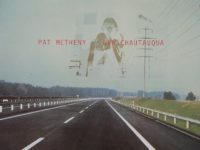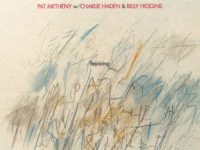I’ve always been amazed that Bright Size Life was Pat Metheny’s debut recording.
With Bob Moses on drums and Jaco Pastorius on bass, Metheny produced an album that was both unique and instantly timeless. It’s one of those “stars in alignment” sort of things. And now, decades after its 1976 release, the music is still fresh.
The title track gives you almost all you need to know about this group of musicians. Metheny begins unaccompanied for a quick ascending line before Pastorius drops in with a single low note followed by one of his trademark ringing artificial harmonics. As Pat Metheny continues to flesh out each chorus, the bass moves beyond a mere supporting role, becoming a parallel source of improvisation. When Metheny drops back mid-tune to let Pastorius take a solo, it’s clear that Pastorius and Metheny are of like minds.
Let’s not forget Bob Moses, who brilliantly fills in any harmonic empty spaces with the most musical cymbal and rimshot work you’re ever likely to hear. Bright Size Life is laced with so many instances of this type of magical interplay that they’re just too numerous to mention, though “Missouri Uncompromised” is worth noting for its breathtaking “unison soloing.”
What I’ve always found interesting about Bright Size Life is that many parts of Metheny’s musical future are telegraphed by the compositions. There’s the Midwestern openness of “Unity Village,” highly angular approaches to melodic lines (“Omaha Celebration”), and of course, Ornette Coleman. Bright Size Life ends with an exhilarating run through Coleman’s “Round Trip/Broadway Blues.”
It’s a stunning conclusion to one of my favorite jazz albums. Here’s a deeper dive:
‘SIRABHORN’
“Sirabhorn” is only the second tune in the Pat Metheny catalog, and we already have an example of his Midwestern sound. The chiming opening bars have that open, pastoral sound that Metheny has said is rooted in his Missouri upbringing. The introduction serves to frame the melodic story that the trio will wrap themselves in.
Much like the title track, Jaco Pastorius comes along to play a solo that both extends and supports that story. I’m not sure if I was aware of it back in the day, but now it’s just so obvious that the two musicians were made for each other. Two songs into this debut album, and it sounds like they’ve been playing together for a lifetime. It’s a rare thing.
‘UNITY VILLAGE’
Here we have Pat Metheny’s solo guitar remembrance of weekend gigs at the Unity School of Christianity. The church was a part of the Metheny family history, as both his dad and his brother had played in the church’s Unity Village Band.
The architecture of “Unity Village” is fairly simple, split between two guitars: one playing the changes (and later comping) and the other playing variations on the head. This might make it sound like a “normal” jazz tune, but here we have an early example of what sets Metheny apart: While he takes a few passes through those changes, his lines sound less like improvisations threaded through harmonic structures than a through-composed melodic story. Later in his career Metheny would say that his music, taken in total, is in many ways one long song. That song starts here.
(A point of trivia: true jazz nerds will know what “Unity Village” was a part of the legendary “Real Book,” appearing as “Exercise #6.”)
‘MISSOURI UNCOMPROMISED’
Decades years removed from this album’s release, and I am still stunned at tracks such as “Missouri Uncompromised.” Metheny has a theme, but the presentation is one long guitar solo. Instead of expansions on lyricism, we have Metheny running up and down on the neck, playing counterpoint to Jaco Pastorius’ active phrasing.
Or … is it Pastorius countering Metheny’s active phrasing? That’s what is so amazing about “Missouri Uncompromised.” Pastorius and Bob Moses weave a rhythmic and harmonic bed that’s just perfect for Pat Metheny’s explorations. But after a fashion, the rhythm section steps away from that subordinate role and becomes part of the whole. It’s a subtle move that’s characteristic of the this trio’s style of play.
I sometimes wonder how Metheny was able to develop these constructs at such a young age. But then I remember the stories of his brother bringing home jazz records (‘Four’ and More) and how he immersed himself in them. It’s not that I hear a lot (or any) of Miles Davis in this, but it’s incredible never the less.
‘MIDWESTERN NIGHTS DREAM’
The key to “Midwestern Nights Dream” lies in the introspective introduction. In fact, its first two chords. They create a quiet, descending arc that when expanded upon gives a sense of falling. When people use the cliché that Pat Metheny’s music is too “pretty,” I want to point them here, because that first minute or so provides a very early (career-wise) counterexample.
With another guitar holding an arpeggio in the background, Metheny surrounds those two chords with both chime and a few bits of blooming dissonance. If you’re paying attention, there’s more than a little bit of darkness and foreboding. And then the full trio kicks in to run with that falling/climbing theme.
Halfway through Bright Size Life, and I fear I may run out of superlatives. Bob Moses’ work on the cymbals is incredibly sensitive; Pastorius seems to have gotten inside of Metheny’s head, playing lines that manage to summon endless, perfect inversions of the underlying harmonic material.
I don’t go many weeks (if even days) without listening to this album, but this recently opportunity to re-explore it with some close listening has brought home again just how much opportunity there was in this lineup. No wonder Pat Metheny looks back on those sessions so wistfully.
‘UNQUITY ROAD’
Here we almost have a traditional jazz tune with the head being played followed by the expected improvisations. But on “Unquity Road,” Pat Metheny and Jaco Pastorius work in a kind of near-unison. They play off of each other with Pastorius’ occasional slight deviations giving the theme all that much more energy.
In the wrong hands, this idea might fall flat but Metheny’s composition, built on series of rapid chord changes presented in a three-note motif, gives a feeling of almost inevitable forward motion. This is also the first Bright Size Life track where Metheny really lets loose on a solo, working in (what would become his signature) chiming arpeggios along with a few very un-jazzlike peaks. No solo for Pastorius here, but there’s so much bass going on that you’d hardly notice.
‘OMAHA CELEBRATION’
If “Unquity Road” came the closest to what we think of as a traditional jazz tune, “Omaha Celebration” confirms that this particular trio is just not going to approach “normal.” Like so many of the compositions on Bright Size Life, this track avoids the tradition by unfolding the harmonic story with nonstop group interplay.
Pat Metheny doesn’t just introduce the melody line as fodder for improvisation. Instead, “Omaha Celebration” launches directly into a long-form chord solo, with Bob Moses’ snare and cymbal work tightly binding Jaco Pastorius’ bass lines to Metheny’s source material. In yet another example of this group’s musical alchemy, the story that unfolds seems inevitable.
Returning to the idea of a chord solo for a moment, it must be noted that this really isn’t a traditional chord solo — in that Metheny is not extending a written melody with a series of interlinked chords. Here ,the chords themselves are the story.
A modern (and not at all jazz-based) parallel is the work that Johnny Marr did with the Smiths. Marr had a somewhat unconventional way of implying a theme via chord changes and arpeggios, creating a unique sound by side-stepping the conventions of rock guitar. Hmmm … you think Johnny Marr owns a copy of this record?
‘ROUND TRIP / BROADWAY BLUES’
Bright Size Life concludes with Pat Metheny finally tipping his hand on his love for Ornette Coleman. The trip rips through two selections from New York Is Now, first with a fairly straight reading of “Round Trip,” followed by a driving segment of “Broadway Blues.” Metheny and company had some big shoes to fill here as that particular Ornette album, something of an outlier in his catalog, was made with the absolutely stellar lineup of Jimmy Garrison on bass, the great Elvin Jones on drums, and Dewey Redman joining Coleman on saxes.
The solo segments on “Round Trip” are particularly exhilarating, with Metheny taking the first slot as Coleman did on the original. He begins with a few short descending arpeggios before jumping in with full force. In many interviews, Metheny has spoken of sometimes modeling his lines after horn players and that approach is evident here. Metheny’s improvisations here are not particularly “guitaristic,” with a lot of space to breathe left between the diving and darting runs.
He hands off the solo stage to Jaco Pastorius and Bob Moses with a restatement of the theme, with the great bass player going on to reveal some harmonic chambers you just never knew were present in this composition. Seemingly amped up by “Round Trip,” the group then runs joyously through “Broadway Blues.” While not nearly as funky as the Ornette Coleman version, it certainly does not lack for enthusiasm.
- Why the Rolling Stones’ Harrowing ‘Gimme Shelter’ is Still Revealing New Depths - November 18, 2024
- How Talking Heads’ ‘Fear of Music’ Opened Up a World of Art and Sound - August 5, 2024
- How Deep Cuts Propelled Bruce Springsteen’s ‘Born in the U.S.A.’ - June 4, 2024




